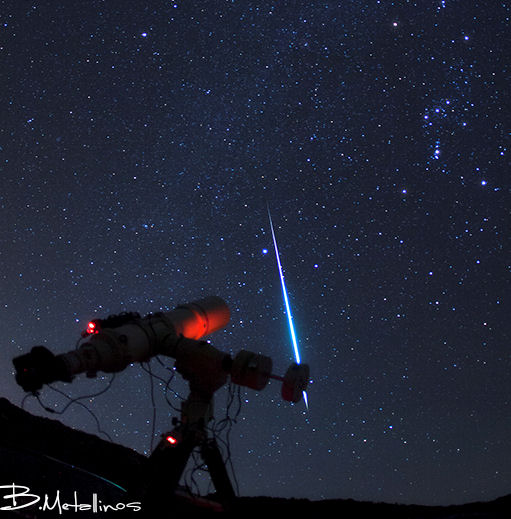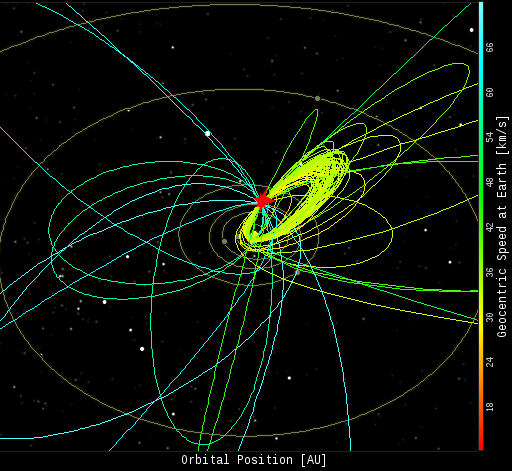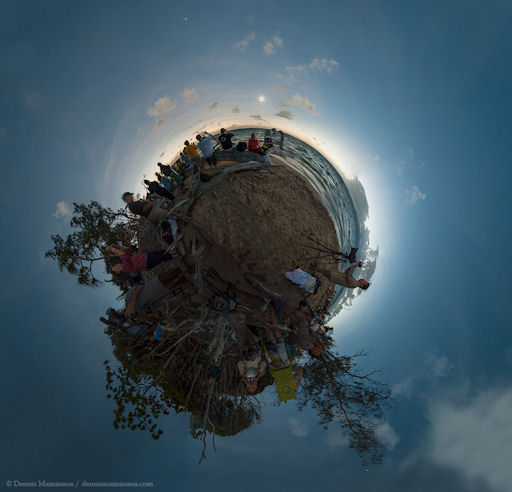THE GEMINID METEOR SHOWER IS UNDERWAY: International observers are counting as many as 50 meteors per hour as Earth plunges into a stream of debris from rock comet 3200 Phaethon. Rates could double, or more, when the shower peaks on Dec. 13th and 14th. The best time to look is during the dark hours before dawn on Thursday and Friday. [sky map] [meteor radar] [video]
This morning, Dec. 13th, Bill Metallinos caught a shadow-casting Geminid fireball streaking over Corfu, Greece:
"I was setting up my telescope when suddenly there appeared a fireball so bright it made my heart beat like crazy," says Metallinos. "Spectacular moment!"
Last night, NASA's network of all-sky meteor cameras detected 56 Geminid fireballs streaking over the southern United States. The multi-camera system automatically triangulates to find the orbits of any meteoroids it detects. Here is last night's orbit diagram:
Orbits in the diagram are color-coded by velocity. Yellow orbits correspond to the Geminids; they are a good match to the orbit of parent rock-comet 3200 Phaethon. The other orbits are mostly random meteoroids not associated with the Geminids. The red splat marks the location of Earth.
NASA says that another meteor shower, appearing for the first time this year, could add to the count of Geminids on Dec. 13th. The source of the new shower is Comet 46P/Wirtanen. Veteran sky watcher Doug Zubenel of Kansas sends this report of a possible sighting: "I believe this shower is real, because at ~ 19:30 hrs, CST on Dec. 10th, I saw a very slow-moving meteor nearly as bright as Jupiter enter the frame of my windshield as I was driving east, and it was in Taurus moving toward the Orion/Gemini border. It's path led back through the radiant in Pisces. While this obviously does not prove it was from Wirtanen, it certainly seems likely."
Realtime Geminid Photo Gallery
LITTLE PLANET TOTAL ECLIPSE: One month ago today, observers stationed along the cost of Queensland, Australia, witnessed a total eclipse of the sun. Eclipse chaser Dennis Mammana was there, and during the brief minutes of totality he snapped eight panoramic images of his surroundings. Stitching them together, he has created the first-ever "little planet" view of a total eclipse:
"Early in the morning of November 14, 2012, the resort island of Green Island, Australia fell dark as Moon's shadow drifted across its spectacular scenery," he recalls. Take a close look at the full-sized image, he advises. "Above the eclipse shines the planet Venus; on the other side of the scene--behind the trees--appears the bright star Sirius."

![]()
Solar wind
speed: 270.1 km/sec
density: 3.5 protons/cm3
explanation | more data
Updated: Today at 2307 UT
![]()
X-ray Solar Flares
6-hr max: C1 1923 UT Dec13
24-hr: C1 1923 UT Dec13
explanation | more data
Updated: Today at: 2300 UT
![]()
![]()
![]()
Daily Sun: 13 Dec 12
![]()
![]()
New sunspots AR1631 and AR1632 are growing rapidly, but not yet producing any significant flares. Credit: SDO/HMI
![]()
![]()
![]()
Sunspot number: 82
What is the sunspot number?
Updated 13 Dec 2012
Spotless Days
Current Stretch: 0 days
2012 total: 0 days (0%)
2011 total: 2 days (<1%)
2010 total: 51 days (14%)
2009 total: 260 days (71%)
Since 2004: 821 days
Typical Solar Min: 486 days
Update 13 Dec 2012
The Radio Sun
10.7 cm flux: 112 sfu
explanation | more data
Updated 13 Dec 2012
![]()
![]()
![]()
Current Auroral Oval:
![]()
Switch to: Europe, USA, New Zealand, Antarctica
Credit: NOAA/POES
![]()
![]()
![]()
Planetary K-index
Now: Kp= 0 quiet
24-hr max: Kp= 1 quiet
explanation | more data
![]()
Interplanetary Mag. Field
Btotal: 3.0 nT
Bz: 0.0 nT
explanation | more data
Updated: Today at 2306 UT
![]()
![]()
![]()
Coronal Holes: 13 Dec 12
![]()
![]()
Solar wind flowing from this southern coronal hole should reach Earth on Dec. 16-17. Credit: SDO/AIA.
Mystery Light Flash?







